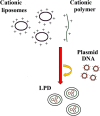A sight on the current nanoparticle-based gene delivery vectors
- PMID: 24936161
- PMCID: PMC4046008
- DOI: 10.1186/1556-276X-9-252
A sight on the current nanoparticle-based gene delivery vectors
Abstract
Nowadays, gene delivery for therapeutic objects is considered one of the most promising strategies to cure both the genetic and acquired diseases of human. The design of efficient gene delivery vectors possessing the high transfection efficiencies and low cytotoxicity is considered the major challenge for delivering a target gene to specific tissues or cells. On this base, the investigations on non-viral gene vectors with the ability to overcome physiological barriers are increasing. Among the non-viral vectors, nanoparticles showed remarkable properties regarding gene delivery such as the ability to target the specific tissue or cells, protect target gene against nuclease degradation, improve DNA stability, and increase the transformation efficiency or safety. This review attempts to represent a current nanoparticle based on its lipid, polymer, hybrid, and inorganic properties. Among them, hybrids, as efficient vectors, are utilized in gene delivery in terms of materials (synthetic or natural), design, and in vitro/in vivo transformation efficiency.
Keywords: Gene delivery; Inorganic vectors; Nanoparticles; Non-viral vectors.
Figures
References
-
- Pouton CW, Seymour LW. Key issues in non-viral gene delivery. Adv Drug Deliv Rev. 2001;9(1–3):187–203. - PubMed
-
- Hendriks WT, Ruitenberg MJ, Blits B, Boer GJ, Verhaagen J. Viral vector-mediated gene transfer of neurotrophins to promote regeneration of the injured spinal cord. Prog Brain Res. 2004;9:451–476. - PubMed
LinkOut - more resources
Full Text Sources
Other Literature Sources



